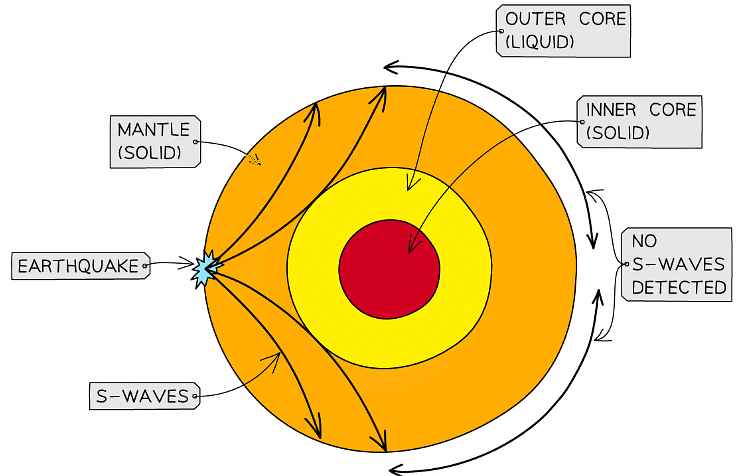Grade 10 Exam > Grade 10 Notes > Physics for Grade 10 > Seismic Waves
Seismic Waves | Physics for Grade 10 PDF Download
| Table of contents |

|
| What are Seismic Waves |

|
| P-Waves |

|
| S-Waves |

|
| Discoveries from Seismic Waves |

|
What are Seismic Waves
- Earthquakes produce two types of waves:
- P-waves (primary waves)
- S-waves (secondary waves)
- These waves pass through the Earth’s centre and can be detected at various points around the Earth using seismometers
- By carefully timing the arrival of the waves at each point, the location of the earthquake, along with its magnitude, can be pinpointed
P-Waves
- P-waves are longitudinal waves
- These waves can pass through solids and liquids
- P-waves are faster than S-waves
- They are very low frequency sound waves known as infrasound
- Infrasound is any sound below the frequency of human hearing (<20 Hz)
- The waves refract as they pass through the different layers of the Earth
- This refraction affects the regions in which waves can be detected, yielding important information about the nature and size of the Earth’s various layers
 Low frequency sound waves (P-waves) produced by earthquakes, pass through the centre of the Earth, revealing useful information about its structure
Low frequency sound waves (P-waves) produced by earthquakes, pass through the centre of the Earth, revealing useful information about its structure
S-Waves
- S-waves are a type of transverse wave
- Unlike P-waves, S-waves are unable to travel through liquids
- They pass through solids only
- S-waves are slower than P-waves
- This means that they are unable to travel through the Earth’s molten (liquid) outer core – providing important evidence about its state and size

Transverse S-Waves are unable to pass through the Earth’s liquid outer core
Discoveries from Seismic Waves
- The interior of the Earth is not directly observable as it is not physically possible to drill that far
- The furthest humans have managed to drill down is 12.2 km - whereas the radius of the Earth is over 6000 km!
- Seismic waves provide vital evidence that has led to a greater understanding of the structure of the Earth
- The two main discoveries are:
- On the opposite side of the Earth to an earthquake, only P-waves are detected, not S-waves, this suggests:
- The mantle is solid – this is because both types of wave can pass through it
- The outer core of the Earth is liquid – hence no S-waves can penetrate it
- Refractions between layers cause two shadow zones, where no P-waves are detected, this suggests:
- The inner core is solid – this is due to the size and positions of these shadow zones which indicate large refraction taking place
- On the opposite side of the Earth to an earthquake, only P-waves are detected, not S-waves, this suggests:
The document Seismic Waves | Physics for Grade 10 is a part of the Grade 10 Course Physics for Grade 10.
All you need of Grade 10 at this link: Grade 10
|
122 videos|150 docs|40 tests
|
Related Searches




















